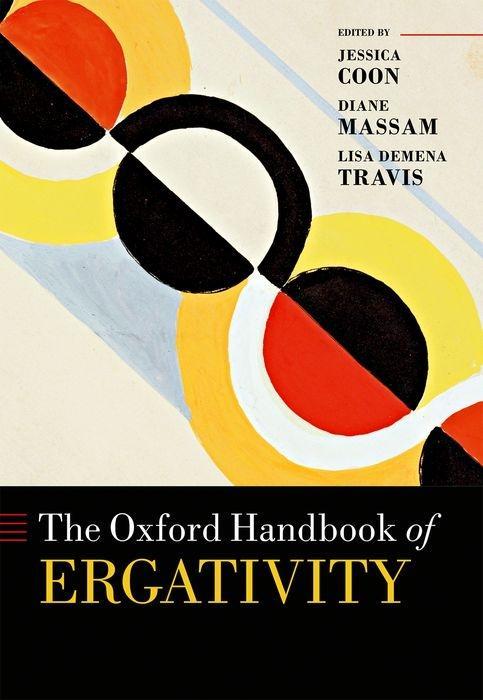
Zustellung: Sa, 28.06. - Fr, 04.07.
Versand in 3-4 Wochen
VersandkostenfreiThis volume examines the phenomenon of ergativity, a grammatical patterning whereby direct objects are in some way treated like intransitive subjects, to the exclusion of transitive subjects. It includes theoretical approaches from generative, typological, and functional paradigms, as well as 16 language-specific case studies.
This volume offers theoretical and descriptive perspectives on the issues pertaining to ergativity, a grammatical patterning whereby direct objects are in some way treated like intransitive subjects, to the exclusion of transitive subjects. This pattern differs markedly from nominative/accusative marking whereby transitive and intransitive subjects are treated as one grammatical class, to the exclusion of direct objects. While ergativity is sometimes referred to as a typological characteristic of languages, research on the phenomenon has shown that languages do not fall clearly into one category or the other and that ergative characteristics are not consistent across languages.
Chapters in this volume look at approaches to ergativity within generative, typological, and functional paradigms, as well as approaches to the core morphosyntactic building blocks of an ergative construction; related constructions such as the anti-passive; related properties such as split ergativity and word order; and extensions and permutations of ergativity, including nominalizations and voice systems. The volume also includes results from experimental investigations of ergativity, a relatively new area of research. A wide variety of languages are represented, both in the theoretical chapters and in the 16 case studies that are more descriptive in nature, attesting to both the pervasiveness and diversity of ergative patterns.
Chapters in this volume look at approaches to ergativity within generative, typological, and functional paradigms, as well as approaches to the core morphosyntactic building blocks of an ergative construction; related constructions such as the anti-passive; related properties such as split ergativity and word order; and extensions and permutations of ergativity, including nominalizations and voice systems. The volume also includes results from experimental investigations of ergativity, a relatively new area of research. A wide variety of languages are represented, both in the theoretical chapters and in the 16 case studies that are more descriptive in nature, attesting to both the pervasiveness and diversity of ergative patterns.
Inhaltsverzeichnis
- 1: Jessica Coon, Diane Massam, and Lisa deMena Travis: Introduction
- PART I: ACCOUNTING FOR ERGATIVITY
- Representing Ergativity
- 2: John W. Du Bois: Ergativity in discourse and grammar
- 3: Michelle Sheehan: Parameterizing ergativity: An inherent case approach
- 4: Anoop Mahajan: Accusative and ergative in Hindi
- The Nature of Ergative Case
- 5: Mark C. Baker and Jonathan David Bobaljik: On inherent and dependent theories of ergative case
- 6: Julie Anne Legate: The locus of ergative case
- 7: Itziar Laka: Ergative need not split: An exploration into the TotalErg hypothesis
- 8: Léa Nash: The structural source of split ergativity and ergative case in Georgian
- PART II: CHARACTERISTICS AND EXTENSIONS
- Characteristics
- 9: Ellen Woolford: Split ergativity in syntax and at morphological spellout
- 10: Jessica Coon and Omer Preminger: Split ergativity is not about ergativity
- 11: Andrej Malchukov: Ergativity and differential case marking
- 12: Gereon Müller and Daniela Thomas: Three-way systems do not exist
- 13: Maria Polinsky: Antipassive
- 14: Knut Tarald Taraldsen: Remarks on the relation between case-alignment and constituent order
- Extensions
- 15: Artemis Alexiadou: Ergativity in nominalization
- 16: Michael Yoshitaka Erlewine, Theodore Levin, and Coppe van Urk: Ergativity and Austronesian-type voice systems
- 17: Alana Johns and Ivona Ku erová: On the morphosyntactic reflexes of the information structure in the ergative patterning of the Inuit language
- 18: Martina Wiltschko: Ergative constellations in the structure of speech acts
- PART III: APPROACHES TO ERGATIVITY
- DIACHRONIC
- 19: William McGregor: Grammaticalization of ergative case marking
- 20: Geoffrey Haig: Deconstructing Iranian ergativity
- 21: Edith Aldridge: Intransitivity and the development of ergative alignment
- 22: Miriam Butt and Ashwini Deo: Developments into and out of ergativity: Indo-Aryan diachrony
- 23: Ritsuko Kikusawa: Ergativity and language change in Austronesian languages
- 24: Daniel Kaufman: Lexical category and alignment in Austronesian
- Acquisition
- 25: Edith Bavin: The acquisition of ergativity: An overview
- 26: Jennifer Austin: The role of defaults in the acquisition of Basque ergative and dative morphology
- 27: Clifton Pye and Barbara Pfeiler: A comparative study of the acquisition of nominative and ergative alignment in European and Mayan languages
- Experimental
- 28: Adam Zawiszewski: Processing ergativity: Behavioral and electrophysiological evidence
- 29: Nicholas Longenbaugh and Maria Polinsky: Experimental approaches to ergative languages
- PART IV: CASE STUDIES
- 30: Judith Aissen: Correlates of ergativity in Mayan
- 31: Mark C. Baker: Ergative case in Burushaski: A dependent case analysis
- 32: Ane Berro and Ricardo Etxepare: Ergativity in Basque
- 33: Miriam Butt: Hindi/Urdu and related languages
- 34: Richard Compton: Ergativity in Inuktitut
- 35: Diana Forker: Ergativity in Nakh-Dagestanian
- 36: Geoffrey Khan: Ergativity in Neo-Aramaic
- 37: Christa König: Ergativity in Africa
- 38: Shobhana Chelliah: Ergativity in Tibeto-Burman
- 39: Mary Laughren: The ergative in Warlpiri: A case study
- 40: Yuko Otsuka: Ergative-absolutive patterns in Tongan: An overview
- 41: Tyler Peterson: Ergativity across Tsimshianic
- 42: Francesc Queixalós: What being a syntactically ergative language means for Katukina-Kanamari
- 43: Andrés Salanova: Ergativity in Jê languages
- 44: Eva Schultze-Berndt: Interaction of ergativity and information structure in Jaminjung (Australia)
- 45: Kevin Tuite: Alignment and orientation in Kartvelian (South Caucasian)
Mehr aus dieser Reihe
Produktdetails
Erscheinungsdatum
15. August 2017
Sprache
englisch
Seitenanzahl
1296
Reihe
Oxford Handbooks
Herausgegeben von
Jessica Coon, Diane Massam, Lisa Demena Travis
Verlag/Hersteller
Produktart
gebunden
Gewicht
1905 g
Größe (L/B/H)
249/173/61 mm
Sonstiges
Print PDF
ISBN
9780198739371
Entdecken Sie mehr
Bewertungen
0 Bewertungen
Es wurden noch keine Bewertungen abgegeben. Schreiben Sie die erste Bewertung zu "The Oxford Handbook of Ergativity" und helfen Sie damit anderen bei der Kaufentscheidung.































